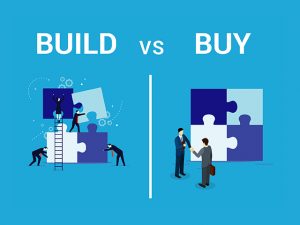4 Reasons Why Pharma Should Buy vs Build Digital Platforms
In the digital age, connecting with patients means embracing new formats of connectivity to deliver personalized and consistent communication across all channels. But venturing into the digital arena poses the question of build-versus-buy, with numerous issues surrounding connectivity, brand, scale, costs, and ownership.
While every pharma organization today is exploring ways to reach its patients in both online and offline channels, the primary question that often arises is “will an ‘out-of-the-box’ solution meet our unique needs?” Chances are an outside company has already solved for those needs and is able to meet whatever unique criteria and limitations there may be. For pharma leaders evaluating the benefits of ‘build vs. buy’, there are four primary criteria that pharma leaders must resolve:
1. Cost Control
In-house IT teams can easily build a digital platform that creates an engaging patient experience and meets the majority of objectives, but it’s an expensive and time-consuming commitment. These costs not only include the initial build and resources, but also include ongoing support. In today’s digital world, having a successful digital platform means more than just ‘set it and forget it.’ It requires costs and resources to continuously upgrade the architecture, integrate new technologies, and capture user data from sources to meet the growing expectation for personalized experiences.
There are also issues of support, bug fixes, upgrades, and keeping up with market trends. The associated cost to launch a digital platform is the reason why one in six IT projects have an average cost overrun of 200% and a schedule overrun of almost 70%. While selecting an outside digital partner may have higher upfront costs, it’s a known expense for a solution that will be ready to use immediately and knows how to create engagement for patients, in proven formats and channels. For many CIOs, this fixed cost vastly outweighs the unpredictability associated with building in-house.
2. Scale for Demand
Pharma companies often start the in-house build with standard tools, on a standard platform and achieve basic economies of scale on that standard. But understanding the unique complexities or nuances related to specific drugs, treatment areas, conditions, and a number of other varying factors means the economies of scale are pushed to the limit.
Existing digital platforms leverage some transactional rules-based engine or machine-learning to perform computational tasks or rules-based activity. They take data, compare it against the rules and then process that data in a timely, consistent fashion. These transactions modules can help companies quickly scale across platforms and within various parts of a company. And an in-house solution must be prepared to deal with regulatory agencies and provide a compliant dashboard and reporting.
3. Connectivity
It may be novel to think that each company has its own ecosystem of applications that need to be compatible with external systems, but a digital platform is ultimately designed to enhance and engage connectivity with patients. Forcing a platform to comply with internal business structures typically hampers its connectivity and usefulness.
IT leaders considering building a digital platform may want to do so to ensure that these connections are made, but internal teams must also be capable of undertaking the extensive process of stitching together multiple, smaller solutions. And creating an in-house solution that is purely designed to meet today’s standards is unlikely thinking of how the platform will adjust to future programs and solutions that could make patient engagement spotty or limited in its function.
More advanced and comprehensive digital engagement solutions already exist on the market. Many of these can even act as an extension of an existing ecosystem, rather than entirely overhaul the architecture an IT team has so arduously built. Plug-and-play can really be that simple.
4. Time-to-value
Many pharma organizations have spent 2–3 years building digital platforms, only to fall short of the requirements needed to make it truly useful. It’s all too common for requirements to fluctuate over time and internal teams may not be able to shift gears fast enough, resulting in poor adoption by patients. IT leaders need to accurately answer the question of whether an in-house team can develop the platform within a reasonable timeframe, and if they can keep up with ever-evolving requirements.
When time is of the essence, utilizing an existing solution from proven vendors will address immediate needs as opposed to waiting years for the solution to be built internally — with the risk of the end-result not solving it entirely. By opting to buy, companies can achieve a shorter time-to-value, heling to keep patients engaged and position themselves ahead of the competition.
The world is abuzz about digital transformation, and pharma continues to explore new ways drive digital engagement that achieve the promised benefits. While many will grapple with the notion of in-house build as a less expensive option, a vendor with proven competencies can launch a unique platform assembled with standard and scalable modules. Whether it’s an underwriting system, a digital drug platform or a mailroom service platform, starting your quest toward digital transformation with standard modules are much less expensive, scale faster, and provide a unique experience that can be configured for each organization.
